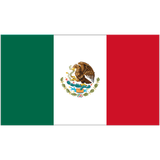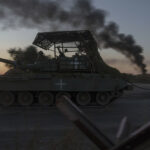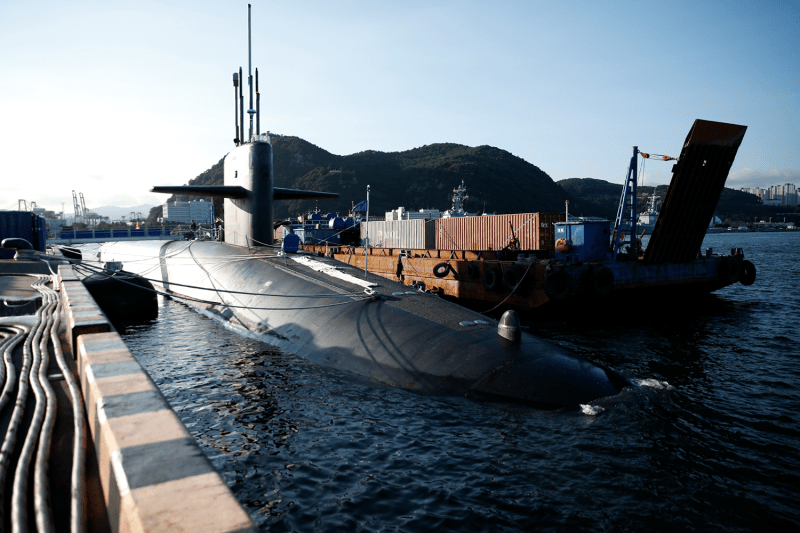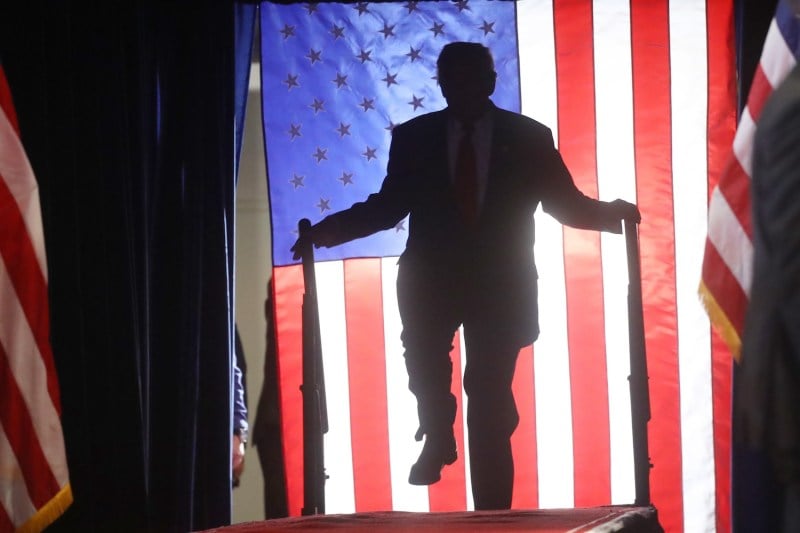Turkish Guns Are Taking Over the U.S. Market

Analysis
Turkish Guns Are Taking Over the U.S. Market
They’re cheap, popular, and spreading beyond borders.
An employee at Machinery and Chemical Industry in Ankara, Turkey on Feb. 22, 2022. Emin Sansar/Anadolu Agency via Getty Images
On Jan. 29, 2022, Sir Michael Morgan Jr., an 18-year-old member of the Muscogee Nation, shot and killed Isaiah Jones, also 18, in Tulsa, Oklahoma. Morgan couldn’t legally own a handgun, so he had borrowed one—a 9 mm semi-automatic Canik pistol with room for 19 rounds of fire.
The shooting coincided with the United States’ peak COVID-19 outbreak, when Americans were buying guns in record quantities and those guns were turning up at crime scenes at record pace. But as inflation rose and some U.S. factories closed for pandemic lockdowns, guns were increasingly imported from countries where production was cheaper and uninterrupted.
On Jan. 29, 2022, Sir Michael Morgan Jr., an 18-year-old member of the Muscogee Nation, shot and killed Isaiah Jones, also 18, in Tulsa, Oklahoma. Morgan couldn’t legally own a handgun, so he had borrowed one—a 9 mm semi-automatic Canik pistol with room for 19 rounds of fire.
The shooting coincided with the United States’ peak COVID-19 outbreak, when Americans were buying guns in record quantities and those guns were turning up at crime scenes at record pace. But as inflation rose and some U.S. factories closed for pandemic lockdowns, guns were increasingly imported from countries where production was cheaper and uninterrupted.
Leading that trend was Turkey, which since 2021 has been the United States’ top gun exporter. And top among Turkish brands is Canik, owned by the parent company Samsun Yurt Savunma (SYS).
At the time of Jones’s murder, the Canik pistol had become a hot commodity, uniquely suited for the growing U.S. market. Gun designers and marketers were trying to expand their customer base among women, children, and Black consumers like Morgan and Jones, and Canik’s 9 mm pistol—designed for small hands, with an easy-to-use trigger and a light frame—was ideal for a shooter with little experience. More importantly, the Canik pistol was cheap, usually costing less than $400.
“Turkey kind of occupies this niche all on their own,” Iain Harrison, a marksman and editor in chief of Recoil magazine, told Foreign Policy. While Turkish manufacturers’ price points compare with lower-quality guns from countries with less developed industries, “quality-wise, even despite the price, they’re right up there with the European guys.”
Though U.S. gun sales have dropped since their peak in 2020 and SYS’s competitors’ sales have largely shrunk, SYS’s brands are growing beyond their pre-pandemic numbers. The company says it can produce up to 460,000 9 mm pistols a year, which would make it second in production after the German giant Sig Sauer—but, crucially, at half the sales price.
Turkish companies’ success in the United States is partly due to their pivot to producing semi-automatic 9 mm pistols—a type of gun that has been linked to gun violence, which disproportionately affects poor neighborhoods. Of the guns traced to crime scenes in 2023, 74 percent were pistols, according to the U.S. Bureau of Alcohol, Tobacco, Firearms, and Explosives (ATF); almost half of those were 9 mm. While information on the makes of these guns is spotty, in a recent study by Everytown for Gun Safety that collected data from 34 cities, four of the 10 most commonly traced brands in 2023 were foreign, including those marked Century Arms, Canik’s importer.
“It’s pretty simple; economic factors influence firearm purchases,” said Sarah Burd-Sharps, former senior director of research at Everytown for Gun Safety. “More access to very cheap guns equals more potential for harm.”
Cheap foreign guns have outperformed local ones in the United States before, but this is the first time that a country with such a young industry and such low production costs has done so well. Further, as U.S. tariffs stand to jolt prices up across the board, Turkish guns may be spared from the biggest hikes.
To those who see gun ownership as a right to self-defense, the popularity of Turkish guns marks a step toward expanding access and diversifying options. But to those who worry that high gun supply spells more harm, it may contribute not only to a more violent United States, but to a more violent world.
Employees are seen during their workday at Machinery and Chemical Industry in Ankara, Turkey on Feb. 22, 2022.Emin Sansar/Anadolu Agency via Getty Images
Ankara invested little in modernizing its small arms manufacturing prior to the 1990s, when war against Kurdish guerrillas created a need for more sophisticated weapons. The state-owned Mechanical and Chemical Industry Corporation (MKE) distributed permits to factory owners, formalizing pockets of a sprawling gun cottage industry.
SYS was the most ambitious of Turkey’s young firms. The family patriarch, Huseyin Cahit Aral, had made a fortune as an industrialist, founding Turkey’s first fruit juice and frozen food factories. His son Zafer bought a small arms workshop in 1998 and, through partnerships with national and multinational defense companies, grew it into a multi-campus, high-tech operation.
This transformation was possible in part because of reforms beginning in 2004 by then-Prime Minister Recep Tayyip Erdogan that aimed to free Turkey’s defense industry from its dependence on Western firms. In this effort, he has largely succeeded. The defense and trade ministries now extend subsidies, marketing support, and favorable loans to enterprising Turkish defense companies and reward them with hefty contracts to arm the military and police.
By the 2010s, boosted by growing gun ownership at home, Turkish firearm companies started eyeing the U.S. market. In 2012, SYS representatives traveled to the Las Vegas SHOT Show, where they met with Century International Arms, the United States’ biggest surplus gun importer. The two agreed to try out a partnership in which Century Arms would help SYS understand American tastes and navigate the legal landscape.
To start, Century Arms executives sent a wish list to SYS engineers of pistol features that would please American gun buyers. The pistols based on these designs sold well, and the profits were reinvested into better engineering.
Canik pistols are now Century Arms’s bestselling gun. And Turkish brands, once marginal, have stacked up multiple industry awards. They have their own fan groups and dedicated forums, and their stands at gun shows bring in loyal crowds.
“I think this is a very beautiful example of a symbiotic relationship,” Adam Ruonala, vice president of marketing and business development for Century Arms, told FP.
A newspaper ad from Klein’s Sporting Goods shows the type of rifle, an Italian-made 6.5 Carcano, that was used to assassinate United States President John F. Kennedy in Dallas in 1963.Bettmann Archives/via Getty Images
The United States has generally prohibited gun imports since 1968, following President John F. Kennedy’s assassination using an Italian Carcano rifle. But this prohibition has only had two major updates since then, and carve-outs remain for guns used for “sporting purposes”—a definition importers quickly found ways of expanding and manipulating to include certain military-style models.
Because of the United States’ patchwork gun laws, some models can be imported but only sold in certain states. Some Turkish semi-automatic pistols are banned in a handful of states because of their large magazine capacity, but dealers simply sell the same gun there with smaller magazines. (Some models, such as several by Austria’s Glock, can even be converted into fully automatic weapons with a cheap but illegal switching device.)
Even guns that fail the “sporting purposes” import test can eventually be sold in the United States. One way of doing this is for a gun maker to import the parts and assemble them locally with a minimum number of U.S.-made parts. The other way is for the foreign company to open a factory in the United States to bypass the compliance process entirely.
A worker restocks AR-15 guns at Davidson Defense in Orem, Utah on March 20, 2020.George Frey/AFP via Getty Images
In 2022, when its new pistol model did not pass the import test, SYS subsidiary Canik USA decided to build its first U.S. factory in Florida and bypass import rules altogether. The factory, which opened in December, has started production with this Canik pistol model and will eventually branch out to heavy machine guns and medium-caliber cannons.
With this move, SYS joins other foreign companies that have onshored production, including Germany’s Sig Sauer, Austria’s Glock, Israel’s IWI, and Brazil’s Taurus. By opening American factories, these companies now have better odds of winning big U.S. government contracts and an easier process for making military-style models, whose sale and manufacture are often much less controlled at U.S. bases than in their home countries.
This onshoring not only deflates companies’ importation figures, but it also obscures the fact that revenues generated in U.S. headquarters eventually cycle back to these companies’ home countries—and their national defense industries.
Last year, SYS brought in $190 million, more than three times the peak amount of U.S. security assistance to Turkey. Washington reduced this assistance in 2020 as it blocked arms exports and sanctioned Turkey for buying a Russian S-400 missile system. Today, even as U.S. defense sanctions remain, American gun buyers are still, in a way, helping fund Turkish companies’ military weapons production, such as SYS’s cannons and turrets and Sarsilmaz’s drone systems and killer robots.
Turkey avoids selling such conventional arms to U.N.-sanctioned countries—with some exceptions—but its small arms sales are tougher to track and regulate. Top gun-producing countries such as the United States and Germany report their firearms sales regularly and even monitor where they end up to help crack down on trafficking; Turkey does not. It also has not yet ratified the U.N.’s Arms Trade Treaty, which bans the sale of both conventional and small arms to countries where there is a “substantial risk” that they will be used in human rights violations.
Total Turkish firearms sales abroad are therefore unknown, but SYS and Sarsilmaz reports show that Turkish handguns have been sold to police and military forces in Pakistan, Egypt, Sudan, Iraq, and the Philippines. They have also shown up in smuggled stockpiles in embargoed countries such as Burkina Faso, Chad, and Libya, according to Interpol and U.N. reports.
Turkish semi-automatic shotguns have also dominated legal gun sales in various conflict areas. Miles Vining, a defense consultant who previously researched small arms in the Middle East, said that he saw Turkish shotguns “all over the place” in Afghanistan, Iraq, Myanmar, and Syria. He said that to criminal actors and insurgents, buying these guns is a “no-brainer” because of their low price and accessibility, and because they have military-esque features such as pistol grips and collapsible buttstocks.
“They occupy a big part of these markets because oftentimes they’re some of the only legal firearms that civilians can have per the books,” Vining said. Not only do these authoritarian countries impose strict gun control on their populations, but arms embargoes prevent them from buying guns from abroad, with the exception of shotguns, whose sale is legal almost everywhere.
Visitors walk around a stand exhibiting pistols produced by Turkish arms manufacturer Sarsilmaz during the International Defence Exhibtion in Abu Dhabi on Feb. 20, 2023.Ryan Lim/AFP via Getty Images
The spread of cheap Turkish guns—to militaries, rebel groups, and criminal gangs around the world—may stem just as much from weak trafficking enforcement as from weak gun control in the United States, which has lifted these brands’ prestige and profits. Tightening U.S. gun laws is certainly more straightforward than tightening international regulation; however, it has proved elusive even to leaders who want to make changes.
U.S. President Donald Trump’s administration, however, might be the first in more than three decades to shake up the flow of foreign guns. In Trump’s first term, the associate deputy director of the ATF had proposed bringing the “sporting” category up to date with action sports, which currently embrace AR-15s and AK-47s.
But this time around, Trump’s presidency may end up upsetting U.S. gun makers more than it rewards them. The ATF is expecting dramatic slashes to its budget, personnel, and purview, perhaps even closure. This may cause a de facto green light for all gun imports, but more likely confusion and backlog for those awaiting arrival.
Moreover, ongoing trade uncertainty is forcing globalized firearms supply chains to untangle themselves from important steel and parts importers, including Canada, China, and Mexico, which will likely drive prices up and sales down. Amid the prospect of uneven worldwide tariffs, the price of European and American firearms stand to climb, just as Turkish guns—which expect only a baseline 10 percent tariff and are made of locally produced steel—are positioned to keep prices low.
While Trump may hope that tariffs will onshore foreign gun manufacturing, they may instead shift the advantage to gun makers less affected by rising costs and relocations. If that is the case, then Turkish companies will not only weather the trade war, but they may also emerge with an even wider lead.
Naomi Cohen is a journalist and documentary filmmaker based in Istanbul. X: @naomireneecohen
Stories Readers Liked
In Case You Missed It
A selection of paywall-free articles

Four Explanatory Models for Trump’s Chaos
It’s clear that the second Trump administration is aiming for change—not inertia—in U.S. foreign policy.



























Join the Conversation
Commenting is a benefit of a Foreign Policy subscription.
Subscribe
Subscribe
Already a subscriber?
.
View Comments
Join the Conversation
Join the conversation on this and other recent Foreign Policy articles when you subscribe now.
Subscribe
Subscribe
Not your account?
View Comments
Join the Conversation
Please follow our comment guidelines, stay on topic, and be civil, courteous, and respectful of others’ beliefs.
View Comments
Change your username |
Log out
Change your username:
CANCEL
Confirm your username to get started.
The default username below has been generated using the first name and last initial on your FP subscriber account. Usernames may be updated at any time and must not contain inappropriate or offensive language.